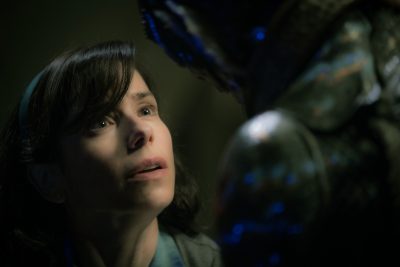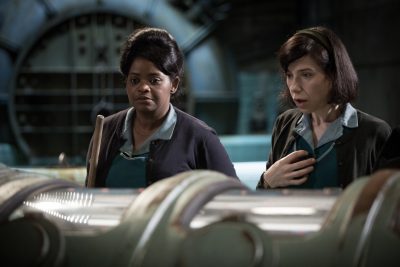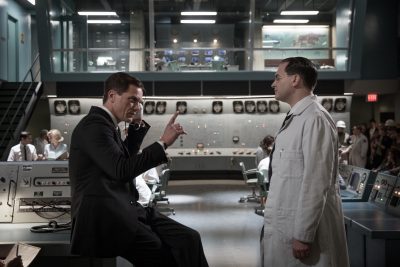
The shape of Water – Elisa Esposito (Sally Hawkins) and the Amphibious Man (Doug Jones) – Photo by Kerry Hayes/Courtesy of Fox Searchlight.
There are noticeable elements from Beauty and the Beast, Creature from the Black Lagoon and even Splash to be found in Guillermo del Toro’s The Shape of Water – but filtered through del Toro’s unique imagination the film is far more than the sum of its parts.
The Shape of Water opens with a brief narration by Richard Jenkins’ Giles. It mentions a prince and princess and a monster and we learn which is which shortly thereafter.
Giles’ narration comes as we see Elisa Esposito Sally Hawkins) move efficiently through the start of her day – being that this is a del Toro film, it includes waking; filling her bathtub; setting three eggs to boil and taking the egg-timer into the bathroom – where she pleasures herself before heading off to work via Giles’ apartment (where she gives him something to eat because he sometimes forgets when he’s working.
Elisa, who is mute, works as a cleaning woman for a government agency – along with her friend Zelda (Octavia Spencer).

The Shjape of Water – Zelda (Octavia spencer) and Elisa (Sally Hawkins) – Photo courtesy of Fox Searchlight.
One night, things change as regular security chief Fleming (David Hewlitt) is superseded by the looming Richard Strickland (Michael Shannon), who has brought an ‘asset’ to be studied. These studies, headed by Dr. Robert Hoffstetler (Michael Stuhlbarg) are intended to give the U.S. a leg up on the Soviet Union (the film is set in 1962).
When she discovers the asset – a humanoid amphibian (Doug Jones) – she is fascinated rather than repulsed. And the feeling begins to be mutual.
When it seems that Hoffstetler’s studies won’t provide useful data, Strickland is ordered to kill him by the seemingly folksy General Hoyt (Nick Searcy). Strickland passes on the task to Hoffstetler, who is appalled because he’s a scientist – and a Soviet spy.
When Elisa learns of the amphibian’s fate, she determines to help him escape. She persuades Giles to help – over his protestations that it would be illegal.

The Shape of Water – Giles (Richard Jenkins) and Elisa (Sally Hawkins) – Photo by Kerry Hayes/Courtesy of Fox Searchlight.
With The Shape of Water, del Toro has taken the basic horror film premise of a monster and changed it to suit his tastes. It takes about five minutes of screen time for us to decide that Strickland is the monster – later scenes show that he’s not even a particularly loving family man…
Elisa, on the other hand is smart and capable, and the bond she builds with the amphibian quickly establishes she is the ‘princess without voice’ mentioned in the opening narration (that is, if we haven’t figured it out in the film’s opening sequence) – which makes the amphibian the prince.
Del Toro isn’t subtle about any of that – though he cleverly hides in plain sight clues that lead to a unique conclusion.
Everything about the film has a watery reference – besides the amphibian, there’s Elisa’s use of the bathub; the film’s palette of blues and greens (Strickland even buys a teal Cadillac Seville), and the way the government facility evokes the claustrophobia of a submarine despite being an open space – and the way the amphibian is brought into that facility in what looks curiously like a torpedo tube.

The Shape of Water – Richard Strickland (Michael Shannon) – Photo by Kerry Hayes/Courtesy of Fox Searchlight.
As a romantic fable, one can read many different things into the film – in fact, del Toro has said in interviews that he enjoys it when his audience does so.
The Shape of Water is a beautifully shot film with a very detailed look that captures the America of the early ‘60s. It’s a love story that plays on a couple of levels.
Giles is gay (it’s possible that cost him a job he is constantly striving to regain), and is attracted to the counter person (Morgan Kelly) at a diner that serves, among other things, a spectacular key lime pie – and Elisa’s arc with the amphibian is as solid a ‘love is love’ statement as you could ask for.
It wouldn’t be a del Toro film without something horrifying or repulsive – even if only for a few seconds. Here there’s an injury that the amphibian inflicts on Strickland, which adds gruesomely to use of the color palette – and the amphibian’s first encounter with a cat.
But while there’s always some kind of horror/repulsion or violence in a del Toro movie, these elements are devices that build his films’ key themes.

The shape of Water – Richard Strickland (Michael Shannon) and Dr. Robert Hoffstetler (Michael Stuhlbarg) in the film THE SHAPE OF WATER. Photo by Kerry Hayes/Courtesy of Fox Searchlight.
In The Shape of Water there is a character who could represent the silent multitudes who only speak when it’s to do someone/something harm. He underlines the more studied and purposeful cruelty of Strickland and Hoyt.
There are other obstacles, too – including Zelda’s not initially wanting to help Elisa and Giles spring the amphibian.
The main themes of the film, though, are the families we choose (Elisa, Giles and Zelda) and the idea that love, given the chance, can conquer all.
It all comes together because of Hawkins’ portrayal of Elisa as a woman of unique strengths and abilities – and Jones’ ability to communicate so much pain and joy and love through multiple layers of prosthetics.
The Shape of Water is definitely del Toro’s best film since Pan’s Labyrinth. It may be his best film.
Final Grade: A+